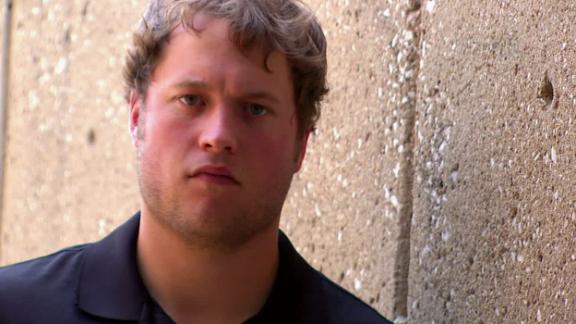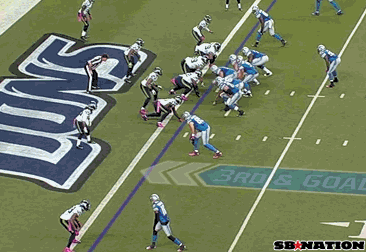11th Play: The final play of the drive gets its own diagram. Lets look at a few subtleties in the figure. First, note how Justin Tuck (91) and the other defensive tackle (Chris Canty, not numbered) are both lined up between the center and a guard. It is fourth-and-one, after all, and the Giants must be wary of a quarterback sneak. Also, notice that there is no defender head-up on Witten (82). The plan is to bracket Witten with a linebacker (Boley, not numbered) and Stevie Brown (27). This play is similar in design, offensively and defensively, to many of the 10 plays that came before it.
Romo has three receivers running short routes to pick up the first down. Not surprisingly, Witten is one of them, and he is running a variation on the out-route he ran many times on this drive. By now, the Giants are waiting for it, and when Romo looks Wittens way, he has no chance of completing a pass, because Boley undercut the route and Brown is glued to the tight end.
Romo has bigger problems. Osi Umenyiora (72), who applied pressure during the scramble earlier in the drive, has once again broken free. When Romo tries to roll away from him, Tuck also eludes his defender. The four-man rush that did not seem to provide enough pressure early in the drive (though it did generate a scramble and a sack negated by a penalty) is making noise when needed most.
One defender who does not join the Romo chase is Jason Pierre-Paul (90). After getting stymied on his first move on this play, JPP drops back to clog any potential passing lanes to Jones or Austin. This is great situational football; the Giants do not need a third lineman chasing Romo, but they do need an extra body guarding the first down line.
So Romo, with two defenders on his tail and no one open, launches a desperate pass to Witten on the sideline. Brown intercepts it, but an incomplete pass would have the same effect on fourth down in the final minutes. The Giants prevented a comeback, and they did it without the prevent.






